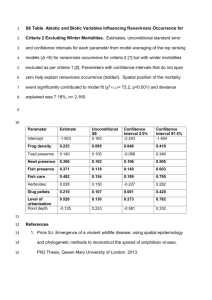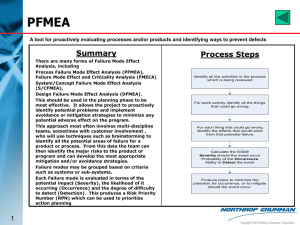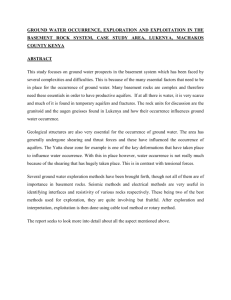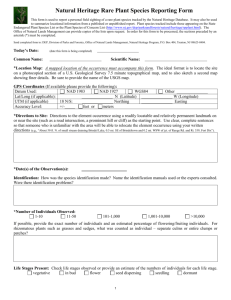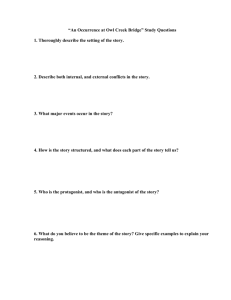MASSACHUSETTS LUC STEELS INTELLIGENCE 1978
advertisement
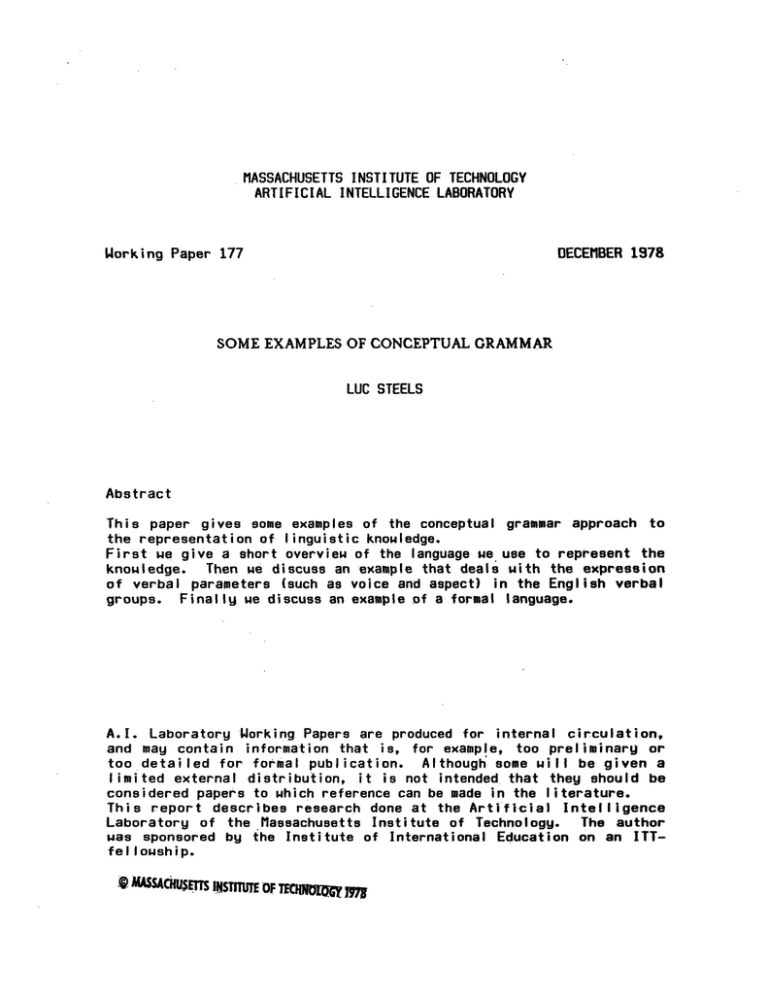
MASSACHUSETTS INSTITUTE OF TECHNOLOGY
ARTIFICIAL INTELLIGENCE LABORATORY
DECEMBER 1978
Working Paper 177
SOME EXAMPLES OF CONCEPTUAL GRAMMAR
LUC STEELS
Abstract
This paper gives some examples of the conceptual grammar approach to
the representation of linguistic knowledge.
First we give a short overview of the language we use to represent the
knowledge. Then we discuss an example that deals with the expression
of verbal parameters (such as voice and aspect) in the English verbal
groups. Finally we discuss an example of a formal language.
A.I. Laboratory Working Papers are produced for internal circulation,
and may contain information that is, for example, too preliminary or
too detailed for formal publication. Although some will be given a
limited external distribution, it is not intended that they should be
considered papers to which reference can be made in the literature.
This report describes research done at the Artificial Intelligence
Laboratory of the Massachusetts Institute of Technology. The author
was sponsored by the Institute of International Education on an ITTfellowship.
MASSA CumS INSTIrrE OF TECHN
PAGE 2
8. INTRODUCTION
In Steels[1978b] I introduced a new way of thinking about linguistics
and linguistic processing which was called conceptual grammar. One of
the major points of conceptual grammar is that the representation of
linguistic information (from the viewpoint of acting as the source of
knowledge in linguistic processing) consists of a set of concepts and a
set of relationships or constraints among the concepts.
The relationships and constraints among the concepts express the
information contained in the axioms of a so called abstract grammar. The
axioms in an abstract grammar represent in a neutral fashion (i.e.
without concern for epistemological adequacy) the constraints on the
linguistic situations one wants to describe. The network of concepts
itself is called the concrete grammar.
A second major point of the approach is concerned with specific claims
about the way the representation of the concepts and their
interrelationships is to be structured and the way the network is
activated.
These claims are embodied in a language design that
contains only those representational primitives that are allowed in the
theory. I will first give a summary of the resulting language because
we will use it throughout the rest of the paper to represent conceptual
grammars. I will here introduce only those representational constructs
that will be needed for the examples we will be discussing.
Also
nothing will be said about the activation of the proposed
representations. For a more extensive introduction, the reader is
invited to consult Steels [1978a].
BRIEF RECAP .OF THE KNOWLEDGE REPRESENTATION LANGUAGE
The first claim is that information is best organized around structures
called frames. A frame contains all the constraints that are known to
hold between the aspects of a certain concept.
We will set up a frame structure as follows
(<frame-name>
(WITH <aspect-i>)
(WITH <aspect-2>) ....
)
For example
(LIST
(WITH CONS)
(WITH CAR)
(WITH CDR))
is a structure for expressing things about the concept of a list. The
the
concept is shown to have three conceptual subparts or aspects:
CONS, the CAR and the CDR. Each aspect introduces a so-called slot.
From a semantic point of view a frame represents a set of possible
configurations between the individuals that may fill the aspects of the
frame. For example if we have a frame for SUM:
PAGE 3
(SUM
(WITH RESULT)
(WITH ADDEND)
(WITH AUGEND))
then the interpretation of this frame (formally speaking) is a set of
tuples of numbers which are in the SUM-relation. Each configuration in
this set is called an instantiation.
In order to express the constraints between the aspects, we attach
descriptions to their slots. There are 3 types of descriptions that we
will use in this paper: simple descriptions, co-referential links and
conditional expressions.
SIMPLE DESCRIPTIONS.
First of all we observe that it is sometimes the case that for each
instantiation of a frame, there is an instantiation of another frame
such that an individual which plays a role in the first instantiation
also plays a role in the second instantiation. For example the result
of a sum is always the value of a number.
In order to write down such a relationship we introduce the notion of a
description. A description does two things: it causes the instantiation
of a certain frame and it specifies the role that an individual plays
in this instantiation. We will call this role the view.
For example if we want to express the fact that the result of a sum is
always the value of a number, we will make VALUE the view of a
description that introduces an instantiation of number.
Descriptions are represented as follows:
(<view> <frame-name>
(WITH <aspect-name-l>) .... (WITH <aspect-name-n>))
As in
(VALUE NUMBER)
which can be read as 'the value of a number', or
(RESULT SUM (WITH ADDEND) (WITH AUGEND))
which can be read as 'the result of a sum with a certain addend and a
certain augend.
Now comes attachment. It is allowed to attach a description to a slot
in a frame. This is done by writing the description after the aspectname introducing the slot. For example, suppose we want to say that
the result of a sum is the value of a number, then we can do this as
follows
(SUM
(WITH RESULT (VALUE NUMBER))
(WITH ADDEND)
(WITH AUGEND))
Descriptions may be attached to any slot, also those introduced by
descriptions. An attached description may act like a selection
PAGE 4
restriction on what kind of things may fill a certain slot, it may act
also like a consequent when we know that an object is the filler of the
slot.
Furthermore it can be shown that descriptions inherit the descriptions
attached to the aspects in the frame used in the description. For
example once we know that the value of a two is the result of a sum, we
know that it is the value of a number.
It is allowed to construct more complex descriptions using the
connectives AND, OR, XOR and NOT, as in
(AND (ADDEND SUM
(WITH RESULT (VALUE TWO))
(WITH AUGEND (VALUE ONE)))
(AUGEND SUM
(WITH RESULT (VALUE TWO))
(WITH ADDEND (VALUE ONE))))
Now we discuss the second type of descriptions:
co-referential
links.
CO-REFERENTIAL LINKS
It may happen that we want to specify more complex relations between
several slots, i.e. not just a relation between one slot (the view) of
a description and a slot in a frame but a relation between a pair of
slots in one instantiation and a pair of slots in another
instantiation. To allow for this capability we have to introduce a new
type of specifying constraints. This new capability is called the coreferential.
Co-referential links are represented by writing (= <unique-name>) after
each slot that is co-referentially related. The name is lexically
scoped within one frame representation.
Supose we have the concept of parent-childHere is an example.
relation as in
(PARENT-CHILD-RELATION
(WITH PARENT)
(WITH CHILD))
and the concept of mother-child-relation with aspects for the mother
and the child, as in
(MOTHER-CHILD-RELATION
(WITH MOTHER)
(WITH.CHILD)).
Now we want to specify that the pair mother-child corresponds to the
pair parent-child. Note that something like
(MOTHER-CHILD-RELATION
(WITH MOTHER
(PARENT PARENT-CHILD-RELATION))
(WITH CHILD
(CHILD PARENT-CHILD-RELATION)))
PAGE 5
is not a sufficient constraint because it does not say that the MOTHER
is the PARENT of the same instantiation of the PARENT-CHILD-RELATION as
the CHILD is the CHILD of.
So we introduce a co-referential link as follows:
(MOTHER-CHILD-RELATION
(WITH MOTHER
(PARENT PARENT-CHILD-RELATION
(WITH CHILD (= THE-CHILD))))
(WITH CHILD
(= THE-CHILD)))
The final type of description we will need here is the conditional.
CONDITIONALS
Conditionals refer to a still more complex constraint, namely one where
it is known that there is a relation between two instantiation sets of
a frame, but this relation only holds if the instantiation we are
looking at is related to another instantiation. We say then that the
first is conditionally related to the second.
For example the PARENT of a PARENT-CHILD-RELATION is the MOTHER of a
MOTHER-CHILD-RELATION if the individual filling up the PARENT slot in
the instantiation of PARENT-CHILD-RELATION is at the same time related
to an instantiation of the FEMALE-PERSON frame. On the other hand the
PARENT of a PARENT-CHILD-RELATION is the FATHER of a FATHER-CHILDRELATION if the individual filling up the PARENT slot in the
instantiation of the PARENT-CHILD-RELATION fills the BEING slot of a
MALE-PERSON frame.
We see that the relation between the PARENT-CHILD-RELATION frame and
the MOTHER-CHILD-RELATION frame is conditionally related to the FEMALE-
PERSON frame.
We will express conditional links as follows. First we introduce the
entity for which the conditional holds by using the name occurring
elsewhere in a co-referential description. Then we give a list of
pairs where the first element is the condition that the entity has to
satisfy in order for the second element to be a valuable description.
All this is represented as
(WHEN <the-referring-name>
(<condition-i> <resulting-description-l>)
(<condition-n> <resulting-descriptin- -n>))
For example
PAGE 6
(WHEN THE-PARENT
((BEING FEMALE-PERSON) ; then
(MOTHER MOTHER-CHILD-RELATION
(WITH CHILD (= THE-CHILD))))
((BEING MALE-PERSON) ; then
(FATHER FATHER-CHILD-RELATION
(WITH CHILD (= THE-CHILD)))))
So when the individual which occurs as interpretation of THE-PARENT is
known to be the filler of the BEING slot in an instantiation of the
FEMALE-PERSON frame, the resulting description is
(MOTHER MOTHER-CHILO-RELATION
(WITH CHILD (= THE-CHILD)))
Conditional expressions may be attached to slots, in the same way as
descriptions. The idea is that the descriptive relation holds between
the individuals filling the slot and the description which would result
from resolving the conditional.
So we have
(PARENT-CHILD-RELATION
(WITH PARENT (= THE-PARENT)
(WHEN THE-PARENT
((BEING FEMALE-PERSON)
(MOTHER MOTHER-CHILD-RELATION
(WITH CHILD (= THE-CHILD))))
((BEING MALE-PERSON)
(FATHER FATHER-CHILD-RELATION
(WITH CHILD (= THE-CHILD))))))
(WITH CHILD (= THE-CHILD)))
A special case of the conditional is the IFF (if and only if)
(IFF <the-referring-name>
(<condition-l> <resulting-description-l>)
(<condition-n> <resulting-description-n>))
This conditional expresses the fact that if the resulting description
holds for the slot-filler to which this description is attached, than
we know that the condition-1 holds. So in fact we could write
(PARENT-CHILD-RELATION
(WITH PARENT (= THE-PARENT)
(IFF THE-PARENT
((BEING FEMALE-PERSON)
(MOTHER MOTHER-CHILD-RELATION
(WITH CHILD (= THE-CHILD))))
((BEING MALE-PERSON)
(FATHER FATHER-CHILD-RELATION
(WITH CHILD (= THE-CHILD))))))
(WITH CHILD (=- THE-CHILD)))
There are many more constructions in the knowledge representation
PAGE 7
language (such as mechanisms for representing properties of aspects
(e.g. criteriality, pro.jectivity or individuality), quoting
descriptions, viewing an instantiation of one frame as the
instantiation of another frame,etc.). But this subset will do for our
present purposes. The interested reader may consult Steels (1978a).
Let us now turn to the topic of this paper.
PAGE 8
1. THE FIRST EXAMPLE
In this paper we will discuss two examples at length.
The first
example is from the domain of natural language. It deals with aspects
of the auxiliary system of English. The second example is from the
domain of formal languages. This example is included for readers who
do not have a linguistic background.
First we try to identify the axioms that underly what we have to
represent.
Then we investigate concepts that are necessary to
represent the information in the axioms. A functional viewpoint will
underly our analysis. We are not only interested in getting the right
sequences of elements as end result, but more importantly we want to
specify the relation between these sequences and their reason for being
there. For our present purposes this means the relation between a set
of specifications for verbal parameters and a sequence of auxiliaries
plus a lexical verb, such as 'WILL HAVE BEEN BEING SEEN'. We will call
such a construction a VERB-GROUP.
The verbal parameters we will concentrate on are
I-- perfective
aspect -I
I-- nonperfective
|-- modal
modality -I
I-- nonmodal
I-- active
voice -'
I-- passive
I-- progressive
duration -I
I-- nonprogressive
Of course to determine the values of each of the initial specifications
we already need complicated knowledge. Think for example how one would
decide whether to use passive or not. But that will not concern us
here.
Also we will not concentrate on other verbal parameters such as tense,
negation or inversion.
One way to define the relation between the verbal specifications and
the corresponding wordforms is to enumerate all possible configurations
of specifications and relate each of them with the corresponding
language form. This is the exhaustive approach. Although it is in
principle possible (the list of cases is presumably finite) still it
does not seem to be a very good solution. Generalizations are missed,
which implies an unnecessary load on the resources available. Also
there is a well known systematicity and it is absurd not to exploit it.
So we start looking for a more refined way of doing the job.
try to identify the 'axioms' underlying the auxiliary system.
First we
The first observation that can be made is that only some values for the
PAGE 9
parameters have an outside realization in natural language.
to the first axiom.
This leads
Axiom 1
Some values for certain parameters are realized by a separate
language form others aren't.
For example, for voice the passive is realized by using BE + pastparticiple, but the active voice is not realized. We will say that
active is the default or, using a linguistic term, the unmarked case.
The unmarked case for modality is nonmodal, for aspect imperfective and
for duration nonprogressive.
Next we investigate what the linguistic form used to express the marked
case looks like.
Axiom 2
The language form used to indicate the marked case involves two
things:
the occurrence of a certain root, and the occurrence of a
certain form.
For example, for the expression of passive we observe an occurrence of
the root BE and the occurrence of the form PAST-PARTICIPLE (or EDFORM).
Similarly for perfective aspect we need root HAVE and form
PAST-PARTICIPLE, for progressive duration we need root BE and form
PRESENT-PARTICIPLE and for modality we need a modal-auxiliary and form
INFINITIVE.
1
Axiom 3
There is an order constraint in that the word expressing the root of
one parameter always immediately precedes the word carrying the form of
the other parameter.
For example in the sequence 'will have been seen', the word with root
HAVE immediately precedes the word with form PAST-PARTICIPLE. Both are
parts of the realization of the aspect parameter. The word with root
BE immediately preceeds the word with form PAST-PARTICIPLE, where both
are parts of the realization of the voice parameter, etc.
Axiom 4
There is a second order constraint in that the expression of the
various parameters occurs in a fixed order:
modality, aspect,
duration, voice. When one of them is not there the next one in the row
follows.
The sequence 'will have been seen' illustrates this observation:
modality, aspect and voice follow each other.
There are other constraints, such as the fact that a word can only once
play a role in a verb-group or the fact that there can only be one
PAGE 18
filler for each of the slots. These constraints are known to be global
constraints on dependency relations (first observed by Tesniere,1959).
Although this would be a nice place to develop the notion of a
universal axiom, it would lead us too far to develop this seriously.
Let us concentrate on the axioms which are unique to the verbal-group
itself.
We now have an abstract grammar of the verb-groups.
It consists of a
set of axioms that specify completely all important properties of what
we called verb-groups (at least the ones we are interested in here).
Finding and justifying these axioms is a matter of empirical research.
For example one could show that axiom3 is necessary because 'will been
have seen' satisfies all axioms, except axiom3,etc.
We now face the task of turning the axioms into a network of concepts.
First of all we introduce the concept of a VERB-GROUP and we will call
a sequence like 'will have been seeing' the OCCURRENCE of a verb-group.
So we get an initial structure like this
(VERB-GROUP
(WITH OCCURRENCE))
Next we introduce aspects of
parameters we are interested
(VERB-GROUP
(WITH OCCURRENCE)
(WITH MODALITY)
(WITH ASPECT)
(WITH DURATION)
(WITH VOICE))
Each of these aspects will
value.
To express these
concepts.
Each concept has
(MODAL
(WITH VALUE))
(NONMODAL
(WITH VALUE))
(PROGRESSIVE
(WITH VALUE))
etc;
the verb-group that correspond to the verbal
in here. This leads us to a structure like
receive a certain specification for its
values we introduce another series of
an aspect for the entity that is the value
Note that a lot more could be attached to the concept of a value, for
example of what it is a value, like in
(MODAL
(WITH VALUE
(MODALITY VERB-GROUP)))
what the semantics of the MODAL value of modality is , etc;
We restrict us here to the essentials.
So far a sequence like 'will have been seen' would be described as
PAGE 11
(OCCURRENCE VERB-GROUP
(WITH MODALITY (VALUE MODAL))
(WITH ASPECT (VALUE PERFECTIVE))
(WITH DURATION (VALUE NONPROGRESSIVE))
(WITH VOICE (VALUE PASSIVE)))
Now we come to the problem of expressing the axioms in terms of the
concepts developed so far. Based on the first axiom we see that we
will need two new aspects for the expression of each of the parameters:
a root and a form. Let us call the first aspect the auxiliary (e.g.
MODAL-AUXILIARY) and the second the successor of the auxiliary (e.g.
These names relate of course to the realization
SUCCESSOR-OF-MODAL).
of these aspects. So we obtain
(VERB-GROUP
(WITH OCCURRENCE)
(WITH MODALITY)
(WITH ASPECT)
(WITH DURATION)
(WITH VOICE)
(WITH MODAL-AUXILIARY)
(WITH SUCCESSOR-OF-MODAL)
(WITH ASPECT-AUXILIARY)
(WITH SUCCESSOR-OF-ASPECT)
(WITH DURATION-AUXILIARY)
(WITH SUCCESSOR-OF-DURATION)
(WITH VOICE-AUXILIARY)
(WITH SUCCESSOR-OF-VOICE))
Let us also introduce an aspect for the HEAD of the group which is the
word that will contain the lexical content and an aspect for the
CARRIER of the group. The carrier is the verbal word that occurs as
the first one in the sequence. Other verbal parameters such as
negation and inversion will be expressed via this carrier. We obtain
then
(VERB-GROUP
(WITH OCCURRENCE)
(WITH HEAD)
(WITH CARRIER)
(WITH MODALITY)
(WITH ASPECT)
(WITH DURATION)
(WITH VOICE)
(WITH MODAL-AUXILIARY)
(WITH SUCCESSOR-OF-MODAL)
(WITH ASPECT-AUXILIARY)
(WITH SUCCESSOR-OF-ASPECT)
(WITH DURATION-AUXILIARY)
(WITH SUCCESSOR-OF-DURATION)
(WITH VOICE-AUXILIARY)
(WITH SUCCESSOR-OF-VOICE)).
PAGE 12
We can now start to attach descriptions specifying the information
related to the other axioms. Axiom2 tells us that there is a specific
root and a specific form for each of the parameters in the marked case.
First of all we need new concepts in order to talk about each of these
constraints. We will have concepts for roots like
(MODAL-AUXILIARY
(WITH OCCURRENCE))
with an aspect for the occurrence of the root. Similarly for
(HAVE-AS-AUXILIARY
(WITH OCCURRENCE))
(BE-AS-AUXILIARY-OF-DURATION
(WITH OCCURRENCE))
(BE-AS-AUXILIARY-OF-VOICE
(WITH OCCURRENCE))
And we will have concepts for the forms with an aspect for the entity
having the form, such as
(INFINITIVE-FORM
(WITH HAVER))
(ED-FORM
(WITH HAVER))
(ING-FORM
(WITH HAVER))
A word like being would then be described as follows
(BEING
(WITH OCCURRENCE
(AND (OCCURRENCE BE-AS-AUXILIARY-OF-VOICE)
(HAVER ING-FORM))))
('Being' can never be the auxiliary of duration)
Now we use these concepts to express the constraints of axiom 2.
(VERB-GROUP
(WITH OCCURRENCE)
(WITH HEAD )
(WITH CARRIER)
(WITH MODALITY (= THE-MODALITY) )
(WITH ASPECT (= THE-ASPECT))
(WITH DURATION (= THE-DURATION))
(WITH VOICE (= THE-VOICE))
(WITH MODAL-AUXILIARY
(IFF THE-MODALITY
((VALUE MODAL) (OCCURRENCE MODAL-AUXILIARY))))
(WITH SUCCESSOR-OF-MODAL
(IFF THE-MODALITY
((VALUE MODAL) (HAVER INFINITIVE-FORM))))
PAGE 13
(WITH ASPECT-AUXILIARY
(IFF THE-ASPECT
((VALUE PERFECTIVE) (OCCURRENCE HAVE-AS-AUXILIARY))))
(WITH SUCCESSOR-OF-ASPECT
(IFF THE-ASPECT
((VALUE PERFECTIVE) (HAVER ED-FORM))))
(WITH DURATION-AUXILIARY
(IFF THE-DURATION
((VALUE PROGRESSIVE) (OCCURRENCE BE-AS-AUXILIARY-OF-DURATION))))
(WITH SUCCESSOR-OF-DURATION
(IFF THE-DURATION
((VALUE PROGRESSIVE) (HAVER ING-FORM))))
(WITH VOICE-AUXILIARY
(IFF THE-VOICE
((VALUE PASSIVE) (OCCURRRENCE BE-AS-AUXILIARY-OF-VOICE))))
(WITH SUCCESSOR-OF-VOICE
(IFF THE-VOICE
((VALUE PASSIVE) (HAVER ED-FORM)))))
In other words to each of the auxiliaries we attach a conditional
description relating the presence of a certain value for the relevant
parameter with the occurrence of a certain auxiliary and to each of the
successors of those auxiliaries we attach a conditional relating the
presence of a certain value for the relevant parameter with the
occurrence of a certain form. For example with the auxiliary of voice
we attach the constraint that if the value for voice is passive there
is cq occurrence of the auxiliary-of-voice and with the successor of
voice we attach the constraint that if the value for voice is passive
this successor has an ed-form
Next we turn to the order constraint expressed in axiom 3. We need to
introduce first of all some concepts that will enable us to talk about
order constraints.
We will do this by having a way to specify the range of a given entity:
(RANGE
(WITH HAVER)
(WITH BEGIN)
(WITH END))
The haver-aspect relates to the entity that has the range.
Then we can introduce order relations among several entities. We will
do this by introducing a concept for SEQUENCE with an aspect LEFTELEMENT for the entity that is on the left, an aspect RIGHT-ELEMENT for
the entity that is on the right:
(SEQUENCE
(WITH LEFT-ELEMENT)
(WITH RIGHT-ELEMENT))
PAGE 14
We define SEQUENCE in terms of the range of the relevant entities:
(SEQUENCE
(WITH LEFT-ELEMENT
(HAVER RANGE
(WITH END (= THE-COMMON-POINT))))
(WITH RIGHT-ELEMENT
(HAVER RANGE
(WITH BEGIN (= THE-COMMON-POINT)))))
This specification can be paraphrased as "the entity which is the leftelement of a sequence has a range of which a certain point, further
called the common point, is the end; the entity which is the rightelement of that same order relation has also a range of which the same
common point is the begin." simply stated, the end of the left-element
is equal to the begin of the right-element.
We now use these concepts to introduce the order constraints of axiom
3.
(VERB-GROUP
(WITH OCCURRENCE)
(WITH HEAD )
(WITH CARRIER )
(WITH MODALITY (= THE-MODALITY) )
(WITH ASPECT (= THE-ASPECT))
(WITH DURATION (= THE-DURATION))
(WITH VOICE (- THE-VOICE))
(WITH MODAL-AUXILIARY
(IFF THE-MODALITY
((VALUE modal)
(AND (OCCURRENCE MODAL-AUXILIARY)
(LEFT-ELEMENT SEQUENCE
(WITH RIGHT-ELEMENT (= THE-SUCCESSOR-OF-MODAL)))))))
(WITH SUCCESSOR-OF-MODAL (= THE-SUCCESSOR-OF-MODAL)
(IFF THE-MODALITY
((VALUE MODAL) (HAVER INFINITIVE-FORM))))
(WITH ASPECT-AUXILIARY
(IFF THE-ASPECT
((VALUE PERFECTIVE)
(AND (OCCURRENCE HAVE-AS-AUXILIARY)
(LEFT-ELEMENT SEQUENCE
(WITH RIGHT-ELEMENT (= THE-SUCCESSOR-OF-ASPECT)))))))
(WITH SUCCESSOR-OF-ASPECT (= THE-SUCCESSOR-OF-ASPECT)
(IFF THE-ASPECT
((VALUE PERFECTIVE) (HAVER ED-FORM))))
(WITH DURATION-AUXILIARY
(IFF THE-DURATION
((VALUE PROGRESSIVE)
(AND (OCCURRENCE BE-AS-AUXILIARY-OF-DURATION)
(LEFT-ELEMENT SEQUENCE
(WITH RIGHT-ELEMENT (- THE-SUCCESSOR-OF-DURATION))))))
(WITH SUCCESSOR-OF-DURATION (= THE-SUCCESSOR-OF-DURATION)
PAGE 15
(IFF THE-DURATION
((VALUE PROGRESSIVE) (HAVER ING-FORM))))
(WITH VOICE-AUXILIARY
(IFF THE-VOICE
((VALUE PASSIVE)
(AND (OCCURRRENCE BE-AS-AUXILIARY-OF-VOICE)
(LEFT-ELEMENT SEQUENCE
(WITH RIGHT-ELEMENT (- THE-SUCCESSOR-OF-VOICE))
(WITH SUCCESSOR-OF-VOICE (= THE-SUCCESSOR-OF-VOICE)
(IFF THE-VOICE
((VALUE PASSIVE) (HAVER ED-FORM)))))
Next we introduce the second order constraint which binds the whole
group tightly together. Axiom 3 says that there is an ordering among
the various parameters: modality, aspect, duration and voice, in such
a way that if one of these is missing the next one in the series is the
successor and so on.
We can express this very nicely by observing that each time the
successor of a certain parameter is identical to the auxiliary that
carries the root of the next parameter in the series, but if that
auxiliary is not expressed (because the value is the unmarked case),
the successor of the first parameter is identical to the successor of
the second parameter.
This leads us to the following specification
(VERB-GROUP
(WITH OCCURRENCE)
(WITH MODALITY (= THE-MODALITY) )
(WITH ASPECT (= THE-ASPECT))
(WITH DURATION (= THE-DURATION))
(WITH VOICE (= THE-VOICE))
(WITH HEAD (= THE-SUCCESSOR-OF-VOICE))
(WITH CARRIER
(IFF THE-MODALITY
((VALUE MODAL)
(= THE-MODAL-AUXILIARY))
(ELSE (= THE-SUCCESSOR-OF-MODAL))))
(WITH MODAL-AUXILIARY
(IFF THE-MODALITY
((VALUE MODAL)
(AND (OCCURRENCE MODAL-AUXILIARY)
(LEFT-ELEMENT SEQUENCE
(WITH RIGHT-ELEMENT (= THE-SUCCESSOR-OF-MODAL)))))))
(WITH SUCCESSOR-OF-MODAL (- THE-SUCCESSOR-OF-MODAL)
(AND
(IFF THE-MODALITY
((VALUE MODAL) (HAVER INFINITIVE-FORM)))
(IFF THE-ASPECT
((VALUE PERFECTIVE) (= THE-ASPECT-AUXILIARY))
PAGE 16
((VALUE IMPERFECTIVE) (= THE-SUCCESSOR-OF-ASPECT)))))
(WITH ASPECT-AUXILIARY (= THE-ASPECT-AUXILIARY)
(IFF THE-ASPECT
((VALUE PERFECTIVE)
(AND (OCCURRENCE HAVE-AS-AUXILIARY)
(LEFT-ELEMENT SEQUENCE
(WITH RIGHT-ELEMENT (- THE-SUCCESSOR-OF-ASPECT)))))))
(WITH SUCCESSOR-OF-ASPECT (= THE-SUCCESSOR-OF-ASPECT)
(AND
(IFF THE-ASPECT
((VALUE PERFECTIVE) (HAVER ED-FORM)))
(IFF THE-DURATION
((VALUE PROGRESSIVE) (= THE-DURATION-AUXILIARY))
((VALUE NONPROGRESSIVE) (= THE-SUCCESSOR-OF-DURATION)))))
(WITH DURATION-AUXILIARY (= THE-DURATION-AUXILIARY)
(IFF THE-DURATION
((VALUE PROGRESSIVE)
(AND (OCCURRENCE BE-AS-AUXILIARY-OF-DURATION)
(LEFT-ELEMENT SEQUENCE
(WITH RIGHT-ELEMENT (= THE-SUCCESSOR-OF-DURATION))))))
(WITH SUCCESSOR-OF-DURATION (= THE-SUCCESSOR-OF-DURATION)
(AND
(IFF THE-DURATION
((VALUE PROGRESSIVE) (HAVER ING-FORM)))
(IFF THE-VOICE
((VALUE PASSIVE) (= THE-VOICE-AUXILIARY))
((VALUE ACTIVE) (= THE-SUCCESSOR-OF-VOICE)))))
(WITH VOICE-AUXILIARY (= THE-VOICE-AUXILIARY)
(IFF THE-VOICE
((VALUE PASSIVE)
(AND (OCCURRRENCE BE-AS-AUXILIARY-OF-VOICE)
(LEFT-ELEMENT SEQUENCE
(WITH RIGHT-ELEMENT (= THE-SUCCESSOR-OF-VOICE)))))))
(WITH SUCCESSOR-OF-VOICE (= THE-SUCCESSOR-OF-VOICE)
(IFF THE-VOICE
((VALUE PASSIVE)
(HAVER ED-FORM)))))
Note that we made the head equal to the successor-of-voice. (The reader
should check whether this is indeed always true.)
To conclude we give some dictionary frames that work out
concepts used in the description of a verb-group
some of the
A frame for the word 'have' (as far as it is relevant here)
(HAVE
(WITH OCCURRENCE
(AND (OCCURRENCE HAVE-AS-AUXILIARY)
(HAVER INFINITIVE-FORM))))
such that
PAGE 17
(HAVE-AS-AUXILIARY
(WITH OCCURRENCE
(ASPECT-AUXILIARY VERB-GROUP)))
Some frames for forms of the word 'be'
(BE
(WITH OCCURRENCE
(OCCURRENCE BE-WORD)))
(BEEN
(WITH OCCURRENCE (OCCURRENCE BE-WORD)))
(BEING
(WITH OCCURRENCE
(AND (OCCURRENCE BE-AS-AUXILIARY-OF-VOICE)
(HAVER ING-FORM))))
Then the word be itself
(BE-WORD
((WITH OCCURRENCE (= THE-OCCURRENCE)
(AND
(XOR (OCCURRENCE BE-AS-AUXILIARY-OF-DURATION)
(OCCURRENCE BE-AS-AUXILIARY-OF-VOICE))
(IFF THE-OCCURRENCE
((HAVER ING-FORM) (OCCURRENCE BEING))
((HAVER ED-FORM )(OCCURRENCE BEEN))
((HAVER INFINITIVE-FORM) (OCCURRENCE BE)))))))
Note the tendency to group information together as much as possible.
Now some frames for the roles a be-word can play
(BE-AS-AUXILIARY-OF-DURATION
(WITH OCCURRENCE
(AND (DURATION-AUXILIARY VERB-GROUP)
(OCCURRENCE BE-WORD))))
We need both descriptions in order to go both ways parsing or producing.
(BE-AS-AUXILIARY-OF-VOICE
(WITH OCCURRENCE
(AND (VOICE-AUXILIARY VERB-GROUP)
(OCCURRENCE BE-WORD))))
Frames for the lexical part of the verb-group would look like this
(WORD-SEE
(WITH OCCURRENCE (= MYSELF)
(AND (HEAD VERB-GROUP)
(IFF MYSELF
((HAVER INFINITIVE-FORM) (OCCURRENCE SEE))
((HAVER ING-FORM) (OCCURRENCE SEEING))
((HAVER ED-FORM) (OCCURRENCE SEEN))))))
where
(SEE
(WITH OCCURRENCE (OCCURRENCE WORD-SEE)))
PAGE 18
(SEEING
(WITH OCCURRENCE (OCCURRENCE WORD-SEE)))
(SEEN
(WITH OCCURRENCE
(OCCURRENCE WORD-SEE)))
etc;
Let us now do an example to gain some further experience with this specification.
We will assume that we know the specifications of a verb-group and we will
then derive a description of the string that realizes this specifications.
Let us start from the following description
(OCCURRENCE VERB-GROUP
(WITH HEAD (OCCURRENCE SEE))
(WITH MODALITY (VALUE MODAL))
(WITH ASPECT (VALUE PERFECTIVE))
(WITH DURATION (VALUE NONPROGRESSIVE))
(WITH VOICE (VALUE PASSIVE)))
in other words we want the complete description of a verb-group for the verb SEE
which expresses that this verb is modal, perfective, nonprogressive and passive.
The result has to be 'WILL HAVE BEEN SEEN'.
Let us first recall the specifications of the verb-group.
(VERB-GROUP
(WITH OCCURRENCE)
(WITH MODALITY (= THE-MODALITY) )
(WITH ASPECT (= THE-ASPECT))
(WITH DURATION (= THE-DURATION))
(WITH VOICE (='THE-VOICE))
(WITH HEAD (= THE-SUCCESSOR-OF-VOICE))
(WITH CARRIER
(IFF THE-MODALITY
((VALUE MODAL)
(= THE-MODAL-AUXILIARY))
(ELSE
(= SUCCESSOR-OF-MODAL))))
(WITH MODAL-AUXILIARY (= THE-MODAL-AUXILIARY)
(IFF THE-MODALITY
((VALUE MODAL)
(AND (OCCURRENCE MODAL-AUXILIARY)
(LEFT-ELEMENT SEQUENCE
([WITH RIGHT-ELEMENT (= THE-SUCCESSOR-OF-MODAL)))))))
(WITH SUCCESSOR-OF-MODAL (= THE-SUCCESSOR-OF-MODAL)
(AND
(IFF THE-MODALITY
((VALUE MODAL) (HAVER INFINITIVE-FORM)))
(IFF THE-ASPECT
((VALUE PERFECTIVE) (= THE-ASPECT-AUXILIARY))
((VALUE IMPERFECTIVE) (= THE-SUCCESSOR-OF-ASPECT)))))
(WITH ASPECT-AUXILIARY (= THE-ASPECT-AUXILIARY)
PAGE 19
(WITH
(WITH
(WITH
(WITH
(WITH
(WITH
(IFF THE-ASPECT
((VALUE PERFECTIVE)
(AND (OCCURRENCE HAVE-AS-AUXILIARY)
(LEFT-ELEMENT SEQUENCE
(WITH RIGHT-ELEMENT (= THE-SUCCESSOR-OF-ASPECTI))))))
SUCCESSOR-OF-ASPECT (= THE-SUCCESSOR-OF-ASPECT)
(AND
(IFF THE-ASPECT
((VALUE PERFECTIVE) (HAVER ED-FORM)))
(IFF THE-DURATION
((VALUE PROGRESSIVE) (- THE-DURATION-AUXILIARY))
((VALUE NONPROGRESSIVE) (= THE-SUCCESSOR-OF-DURATION)))))
DURATION-AUXILIARY (= THE-DURATION-AUXILIARY)
(IFF THE-DURATION
((VALUE PROGRESSIVE)
(AND (OCCURRENCE BE-AS-AUXILIARY-OF-DURATION)
(LEFT-ELEMENT SEQUENCE
(WITH RIGHT-ELEMENT (= THE-SUCCESSOR-OF-DURATION))))))
SUCCESSOR-OF-DURATION (= THE-SUCCESSOR-OF-DURATION)
(AND
(IFF THE-DURATION
((VALUE PROGRESSIVE) (HAVER ING-FORMI))
(IFF THE-VOICE
((VALUE PASSIVE) (= THE-VOICE-AUXILIARY))
((VALUE ACTIVE) (= THE-SUCCESSOR-OF-VOICE)))))
VOICE-AUXILIARY (= THE-VOICE-AUXILIARY)
(IFF THE-VOICE
((VALUE PASSIVE)
(AND (OCCURRRENCE BE-AS-AUXILIARY-OF-VOICE)
(LEFT-ELEMENT SEQUENCE
(WITH RIGHT-ELEMENT (= THE-SUCCESSOR-OF'-VOICE)))))))
SUCCESSOR-OF-VOICE (= THE-SUCCESSOR-OF-VOICE)
(IFF THE-VOICE
((VALUE PASSIVE)
(HAVER ED-FORM))))
HEAD (= THE-SUCCESSOR-OF-VOICE)))
We will call the occurrence of the instantiation of the verb-group we
are working on VERB-GROUP-1. Furthermore let us introduce names for the
individual entities which fill the various slots of this instantiation:
ENTITY-1 (for the modal-auxiliary),
ENTITY-2 (for the successor-of-modal)
ENTITY-3 (for the aspect-auxiliary)
ENTITY-4 (for the successor-of-aspect)
ENTITY-5 (for the duration-auxiliary)
ENTITY-6 (for the successor-of-duration)
ENTITY-7 (for the voice-auxiliary)
ENTITY-8 (for the successor 4-voice)
ENTITY-9 (for the head)
ENTITY-10 (for the carrier)
PAGE 28
Now we ask the question what properties each of these entities has from
the fact that it is the filler of a slot in the verb-group.
For ENTITY-1 (the modal-auxiliary) we obtain
(AND (OCCURRENCE MODAL-AUXILIARY)
(LEFT-ELEMENT SEQUENCE
(WITH RIGHT-ELEMENT (BEING ENTITY-2))))
because the value of the MODALITY aspect is modal and the SUCCESSOR-OFMODAL is ENTITY-2.
For ENTITY-2 (the-successor-of-modal) we obtain
(HAVER INFINITIVE-FORM).
In addition we know that ENTITY-2 is identical to ENTITY-3 because the
value for aspect is PERFECTIVE in this verb-group.
For ENTITY-3 (the aspect-auxiliary) we obtain
(AND (OCCURRENCE HAVE-AS-AUXILIARY)
(LEFT-ELEMENT SEQUENCE
(WITH RIGHT-ELEMENT
(BEING ENTITY-4))))
because the value of the ASPECT aspect is perfective and the SUCCESSOROF-ASPECT is ENTITY-4.
For ENTITY-4 (the successor-of-aspect) we obtain
(HAVER ED-FORM)
and because the value of duration is NON-PROGRESSIVE in this verbgroup, ENTITY-4 is also known to be identical to ENTITY-6 which is the
successor of duration.
We know nothing more about ENTITY-5 (the duration-auxiliary) because
the duration is nonprogressive. However we know that the SUCCESSOR-OFDURATION (here ENTITY-6) is identical to the voice-auxiliary ENTITY-7,
because the voice is PASSIVE.
We know that the description of ENTITY-7 is
(AND (OCCURRENCE BE-AS-AUXILIARY-OF-VOICE)
(LEFT-ELEMENT SEQUENCE
(WITH RIGHT-ELEMENT (BEING ENTITY-8))))
and that ENTITY-8 which is identical to the head of the verb-group
identical to ENTITY-9, has the following description
(AND (OCCURRENCE SEE-WORD)
(HAVER ED-FORM))
Finally we know that the carrier (ENTITY-18) is equal
because the modality is specified as MODAL.
is
to ENTITY-I
If we re-organize this information we see that we have basically
obtained everything we need to know (the rest is a matter of dictionary
Let us see what we know about each of the
lookup so to speak).
entities using the SEQUENCE connections as guideline.
PAGE 21
The first element (ENTITY-1 and also ENTITY-18) is a modal-auxiliary
(such as WILL).
The second element (ENTITY-2 and also ENTITY-3) is an occurrence of the
auxiliary HAVE with an infinitive form.
The third element (ENTITY-4 and also ENTITY-6 and ENTITY-7) is an
occurrence of the auxiliary BE with an ED-form.
Finally the fourth element (ENTITY-8 and also ENTITY-9) is an
occurrence of SEE with an ED-form.
Al I of this corresponds to 'WILL HAVE BEEN SEEN' which is what we
expected.
We now look at a second example from the domain of parsing. We start
with descriptions of words used in the verb-group and request that a
description of the complete verb-group is obtained.
We will pretend that the words come in one at a time. But that is of
no relevance. There is no constraint on the order in which information
comes in. It is even possible to predict pissing elements before they
have been supplied.
We start from the observation that there is a FIRST-WORD which
described as follows
(AND (OCCURRENCE MODAL-AUXILIARY)
(LEFT-ELEMENT SEQUENCE
(WITH RIGHT-ELEMENT (BEING SECOND-WORD))))
is
The frame for MODAL-AUXILIARY would look like
(MODAL-AUXILIARY
(WITH OCCURRENCE
(MODAL-AUXILIARY VERB-GROUP)))
Based on the fact that every occurrence of a modal-auxiliary is the
modal-auxiliary of a verb-group we instantiate a verb-group. That
means that we create (anonymous) entities for each of the entities in
the verb-group. Such as
ENTITY-2 (for the successor-of-modal)
ENTITY-3 (for the aspect-auxiliary)
ENTITY-4 (for the successor-of-aspect)
ENTITY-5 (for the duration-auxiliary)
ENTITY-B (for the successor-of-duration)
ENTITY-7 (for the voice-auxiliary)
ENTITY-8 (for the successor-of-voice)
ENTITY-9 (for the head)
ENTITY-10 (for the carrier)
ENTITY-11 (for the occurrence of the group as a whole)
ENTITY-12 (for the modality)
ENTITY-13 (for the aspect)
etc;
The FIRST-WORD plays the role of MODAL-AUXILIARY in this verb-group.
Next we compute what we already know about each of these entities.
one thing we know that ENTITY-12 (the modality) is described as
For
PAGE 22
(VALUE MODAL)
based on the conditional attached to the modal-auxiliary aspect.
We know also that SECOND-WORD is co-referential with ENTITY-2 because
it is the right-element in a sequence with the modal-auxiliary.
This
same entity is furthermore described as
(HAVER INFINITIVE-FORM)
because this description results from resolving the conditional based
on the fact that the modality has the value of a modal.
Observe how we construct the whole (the 'gestalt' so to speak) as soon
as possible, apd how we start making predictions concerning entities
that still have to occur in the input.
Now comes information about the second word.
described as
(AND (OCCURRENCE HAVE)
(LEFT-NEIGHBOR SEQUENCE
(WITH RIGHT-NEIGHBOR
(BEING THIRD-WORD))))
We will
say that
it
is
Recall the dictionary-frames for HAVE:
(HAVE
(WITH OCCURRENCE
(AND (OCCURRENCE HAVE-AS-AUXILIARY)
(HAVER INFINITIVE-FORM))))
The second conjunct is already predicted (and there would be a
contradiction if that form did not occur).
The first conjunct leads us
to
(HAVE-AS-AUXILIARY
(WITH OCCURRENCE
(ASPECT-AUXILIARY VERB-GROUP)))
So this entity plays again a role in a verb-group. If we can show that
it has to be the same verb-group as the one we already had, we win.
First of all we observe that in this new verb-group the aspect must be
described as
(VALUE perfective)
because that is the only way the auxiliary HAVE could have occured.
Also we observe that the SECOND-WORD must be the SUCCESSOR-OF-MODAL in
this verb-group because when the aspect has the value of a perfective,
the successor-of-modal is co-referential with the aspect-auxiliary
However we knew already that this SECOND-WORD was the
itself.
successor-of-modal of another verb-group. Because of the universal
constraint that a word can only play one role in a certain group, we
must be dealing with the same instantiation of the verb-group frame !
[This is a beautiful example how a global constraint may play an
The FIRST-WORD is the modal-auxiliary of
important role in parsing.]
this verb-group and the SECOND-WORD is at the same time aspectauxiliary and successor-of-modal.
PAGE 23
Also we know already something about the successor of the SECOND-WORD,
namely that it is the successor-of-aspect in this verb-group and that
it will be the haver of an ed-form. It is easy to see that the same
reasoning will apply to further steps in the analysis and we therefore
leave it as an exercise to the reader.
Clearly the reasoning that goes into the activation of linguistic
knowledge is nontrivial but that does not mean that it is intractable.
In fact programs have been written that exhibit the reasoning behavior
sketched in these examples.
PAGE 24
2. THE SECOND EXAMPLE
The second example deals with formal languages. The grammar we will be
looking at deals with a language which contains a number of letters
followed by an equal number of other letters, e.g. aaabbb or dddccceee,
etc.
The first thing we have to do is introduce axioms that specify exactly
and completely what kind of constructions we will have in the language.
The following is an axiom defining a language we are interested in :
Axiom
The language is equal to lanbn I n > 8 1.
Now we have to introduce a number of concepts that express precisely
what is contained in this axiom.
Let us assume that the language we have to define is called L. Then the
major concept we are interested in is 'being a member of L'.
And we
will say that a string like 'aabb' is described as the OCCURRENCE of a
member of L. So we get as a start a concept like
(MEMBER-OF-L
(WITH OCCURRENCE))
We observe that each member of our language has exactly two parts. One
that contains a first sequence of n elements, another that contains a
second sequence of n elements. So we introduce two new aspects:
the
first and the second part of a member of L:
(MEMBER-OF-L
(WITH OCCURRENCE)
(WITH FIRST-PART)
(WITH SECOND-PART))
We now observe that there is a constraint on the relation between the
parts, in particular that the FIRST-PART together with the SECOND-PART
make up the occurrence of the member as a whole. In order to express
this constraint we have to introduce new concepts. In particular we
need the concept of a STRING. A string has an OCCURRENCE and a BEGIN
and an END:
(STRING
(WITH OCCURRENCE)
(WITH BEGIN)
(WITH END))
We will later study what the constraints are between the aspects of a
string but let us first continue how this concept can be used to
express the constraint between the parts of a member of L. One way to
do this is to say that the OCCURRENCE of the whole is the OCCURRENCE of
a STRING with a certain BEGIN and a certain END. The first part can
then be described as the OCCURRENCE of a STRING that has the same BEGIN
as the whole. The second part can be described as the OCCURRENCE of a
,
PAGE 25
STRING that has the same END as the whole. Moreover the END of the
first part is the same as the BEGIN of the second part. So we obtain.
(MEMBER-OF-L
(WITH OCCURRENCE
(OCCURRENCE STRING
(WITH BEGIN (= BEGIN-OF-WHOLE-STRING))
(WITH END (- END-OF-WHOLE-STRING))))
(WITH FIRST-PART
(OCCURRENCE STRING
(WITH BEGIN (= BEGIN-OF-WHOLE-STRING))
(WITH END (= END-OF-FIRST-PART))))
(WITH SECOND-PART
(OCCURRENCE STRING
(WITH BEGIN (= END-OF-FIRST-PART))
(WITH END (= END-OF-WHOLE-STRING)))))
Observe the co-referential links between the BEGIN and END of the
descriptions attached to each of the aspects in MEMBER-OF-L.
The second important constraint on the parts is that they have the same
length. To express this we introduce a new aspect added to the concept
of a string, an aspect expressing length:
(STRING
(WITH OCCURRENCE)
(WITH BEGIN)
(WITH END)
(WITH LENGTH))
Also we introduce a new aspect in MEMBER-OF-L, namely the length of
each of the parts.
((MEMBER-OF-L
(WITH OCCURRENCE)
(WITH FIRST-PART)
(WITH SECOND-PART)
(WITH LENGHT-OF-PARTS) )
Then we can express constraints between the LENGTH of the string in the
parts and the LENGTH-OF-PARTS of a MEMBER-OF-L.
PAGE 26
(MEMBER-OF-L
(WITH OCCURRENCE
(OCCURRENCE STRING
(WITH BEGIN (= BEGIN-OF-WHOLE-STRING))
(WITH END (= END-OF-WHOLE-STRING))))
(WITH FIRST-PART
(OCCURRENCE STRING
(WITH BEGIN (= BEGIN-OF-WHOLE-STRING))
(WITH END (= END-OF-FIRST-PART))
(WITH LENGTH (= N))))
(WITH SECOND-PART
(OCCURRENCE STRING
(WITH BEGIN (= END-OF-FIRST-PART))
(WITH END (= END-OF-WHOLE-STRING))
(WITH LENGTH (= N))))
(WITH LENGTH-OF-PARTS (= N)))
The next constraint has to do with what elements there are in a string.
We will express this by introducing a new concept, namely the concept
of a string with equal elements. This concept will need at least the
same aspects as the concept of STRING (namely BEGIN, END and LENGTH)
but in addition an aspect for the FORM-OF-EACH-ELEMENT:
(STRING-WITH-EQUAL-ELEMENTS
(WITH OCCURRENCE)
(WITH BEGIN)
(WITH END)
(WITH LENGTH)
(WITH FORM-OF-EACH-ELEMENT))
Later we will specify the constraints between the aspects of this
concept.
The form of each element itself will be described in terms of the
occurrence of a certain character. We could to this by having a
concept for a character, e.g. A, with an aspect for the character
itself, as in
(A
(WITH CHARACTER))
This brings us to the next version of our definition of MEMBER-OF-L:
(MEMBER-OF-L
(WITH OCCURRENCE
(OCCURRENCE STRING
(WITH BEGIN (= BEGIN-OF-WHOLE-STRING))
(WITH END (= END-OF-WHOLE-STRING)) ))
(WITH FIRST-PART
(OCCURRENCE (a STRING-WITH-EQUAL-ELEMENTS)
(WITH BEGIN (= BEGIN-OF-WHOLE-STRING))
(WITH END (= END-OF-FIRST-PART))
(WITH LENGTH (= N))
(WITH FORM-OF-EACH-ELEMENT (CHARACTER A))))
(WITH SECOND-PART
PAGE 27
(OCCURRENCE (a STRING-WITH-EQUAL-ELEMENTS)
(WITH BEGIN (= END-OF-FIRST-PART))
(WITH END (= END-OF-WHOLE-STRING))
(WITH LENGTH (= N))
(WITH FORM-OF-EACH-ELEMENT(CHARACTER B))))
(WITH LENGTH-OF-EACH-PART (= N) ))
This gives us a pretty complete picture of what it means to be a member
of L The only thing that remains is to be a bit more specific about
what it means to be the LENGTH-OF-EACH-PART.
We know that this is a number greater than 8. So we have to introduce
some concepts that will enable us to talk about numbers. The concept
we will use is that of a number which has two aspects a value and a
predecessor:
(NUMBER
(WITH VALUE)
(WITH PREDECESSOR))
For example we can describe the number 1 as the value of a number with
predecessor the value of 0:
(1
(WITH NUMBER
(VALUE NUMBER
(WITH PREDECESSOR (VALUE 8)))))
Using this concept we can introduce the final constraint on the MEMBEROF-L , namely that the LENGTH-OF-EACH-PART has to be a number which is
greater than 1:
(MEMBER-OF-L
(WITH OCCURRENCE
(OCCURRENCE STRING
(WITH BEGIN (= BEGIN-OF-WHOLE-STRING))
(WITH END (= END-OF-WHOLE-STRING)) ))
(WITH FIRST-PART
(OCCURRENCE (a STRING-WITH-EQUAL-ELEMENTS)
(WITH BEGIN (= BEGIN-OF-WHOLE-STRING))
(WITH END (= END-OF-FIRST-PART))
(WITH LENGTH (= N))
(WITH FORM-OF-EACH-MEMBER
(CHARACTER A))))
(WITH SECOND-PART
(OCCURRENCE (a STRING-WITH-EQUAL-ELEMENTS)
(WITH BEGIN (= END-OF-FIRST-PART))
(WITH END (= END-OF-WHOLE-STRING))
(WITH LENGTH (= N))
(WITH FORM-OF-EACH-MEMBER
(CHARACTER B))))
(WITH LENGTH-OF-EACH-PART (= N)
(AND (VALUE NUMBER)
(NOT (NUMBER 8)))))
PAGE 28
We are left with the task of working out the details of the concepts
used in this description. First we will look at the concept of a
string with equal elements. Recall that this concept had the following
conceptual subparts:
(STRING-WITH-EQUAL-ELEMENTS
(WITH OCCURRENCE)
(WITH BEGIN)
(WITH END)
(WITH LENGTH)
(WITH FORM-OF-EACH-MEMBER))
If we leave for the moment the problem of specifying the constraints on
the FORM-OF-EACH-MEMBER aspect, we see that the other aspects can be
related to each other using the concept of a STRING itself:
(STRING-WITH-EQUAL-ELEMENTS
(WITH OCCURRENCE
(OCCURRENCE STRING
(WITH BEGIN (= THE-BEGIN) )
(WITH END (= THE-END))
(WITH LENGTH (= THE-LENGTH))))
(WITH BEGIN (= THE-BEGIN))
(WITH END (= THE-END))
(WITH LENGTH (= THE-LENGTH))
(WITH FORM-OF-EACH-MEMBER))
In other words a string with equal elements is a particular kind of
string. Strings with equal elements inherit all properties of strings
via the description attached to its OCCURRENCE-aspect.
But now what about the FORM-OF-EACH-MEMBER aspect. In order to say
things about that we will have to extend the concept of a string so
that we can talk about the characters that are contained in it. How
will we do this.
Let us add two new aspects to the concept of a string. One aspect is
filled by the object that is the first element of the string, another
aspect is filled by the rest of the string (which is again a string):
(STRING
(WITH OCCURRENCE)
(WITH BEGIN)
(WITH END)
(WITH FIRST-ELEMENT)
(WITH REST-OF-STRING))
We have been using the notion of an element loosely. To make it all
This is
precise, we need the concept of an element of a string.
something that has an occurrence,a form, a begin and an end:
PAGE 29
(ELEMENT-OF-STRING
(WITH OCCURRENCE)
(WITH FORM)
(WITH BEGIN)
(WITH END))
and the form is filled by a certain character. Let A be such a
character, then we can say
(A
(WITH CHARACTER
(FORM ELEMENT-OF-STRING)))
in other words the concept A has a CHARACTER aspect and things filling
the slot introduced by this aspect are the FORM of an element of a
string.
We can now define the concept of a STRING-WITH-EQUAL-ELEMENTS by
observing that the form of the first element is equal to the form
described as the FORM-OF-EACH-ELEMENT and that the rest of the string
is also the OCCURRENCE of a STRING-WITH-EQUAL-ELEMENTS with the same
form for each of the elements.
(STRING-WITH-EQUAL-ELEMENTS
(WITH OCCURRENCE
(OCCURRENCE STRING
(WITH BEGIN (= THE-BEGIN) )
(WITH END (= THE-END))
(WITH FIRST-ELEMENT
(OCCURRENCE CHARACTER
(WITH FORM (- THE-FORM-OF-EACH-CHARACTER))))
(WITH REST-STRING
(WHEN THE-LENGTH
((VALUE 8) (OCCURRENCE EMPTY-STRING) )
(ELSE
(OCCURRENCE STRING-WITH-EQUAL-ELEMENTS)
(WITH FORM-OF-EACH-MEMBER
(= THE-FORM-OF-EACH-MEMBER))
(WITH END (= THE-END))
(WITH LENGTH
(PREDECESSOR NUMBER
(WITH VALUE (-THE-LENGT
(WITH LENGTH (= THE-LENGTH))))
(WITH BEGIN (= THE-BEGIN))
(WITH END (= THE-END))
(WITH LENGTH (= THE-LENGTH))
(WITH FORM-OF-EACH-MEMBER (= THE-FORM-OF-EACH-CHARACTER)))
Note how we introduced a conditional for the recursive definition of the
REST-STRING aspect.
What remains is a discussion of the concept of string.
structure of this concept
Recall
the
PAGE 38
(STRING
(WITH OCCURRENCE)
(WITH BEGIN)
(WITH END)
(WITH FIRST-ELEMENT)
(WITH REST-STRING)
(WITH LENGTH))
The question is again what are the constraints on this concept. First
of all we observe that the rest is a string such that the end of the
rest is necessarily the end of the whole string and that the length of
the rest is one unit less than the length of the whole string:
(STRING
(WITH OCCURRENCE)
(WITH BEGIN)
(WITH END (= THE-END))
(WITH FIRST-ELEMENT)
(WITH REST
(OCCURRENCE STRING
(WITH END (= THE-END))
(WITH LENGTH
(PREDECESSOR NUMBER
(WITH VALUE (= THE-LENGTH))))))
(WITH LENGTH (= THE-LENGTH)))
Next we concentrate on the FIRST-ELEMENT of the string. We observe
that this element is to be the OCCURRENCE of an ELEMENT-OF-STRING such
that the BEGIN corresponds to the begin of the whole string and the END
corresponds to the BEGIN of the string filling the REST-STRING. Thus
we obtain
(STRING
(WITH OCCURRENCE)
(WITH BEGIN (= THE-BEGIN))
(WITH END (= THE-END))
(WITH FIRST-ELEMENT
(OCCURRENCE ELEMENT-OF-STRING
(WITH BEGIN (= THE-BEGIN))
(WITH END (= THE-END-OF-THE-FIRST-ELEMENT))))
(WITH REST-STRING
(WHEN THE-LENGTH-OF-THE-REST
((NUMBER 8) (OCCURRENCE EMPTY-STRING))
(ELSE
(OCCURRENCE STRING
(WITH BEGIN (= THE-END-OF-THE-FIRST-ELEMENT))
(WITH END (= THE-END))
(WITH LENGTH
(= THE-LENGTH-OF-THE-REST))))))
(WITH LENGTH (= THE-LENGTH)
(PREDECESSOR NUMBER
(WITH VALUE (= THE-LENGTH-OF-THE-REST)))))
The final concept which we have to make explicit is that of an empty
PAGE 31
string. The only thing useful we want to say about it here is that it
is the occurrence of a string.
(EMPTY-STRING
(WITH OCCURRENCE
(OCCURRENCE STRING)))
This ends our presentation of the grammar.
Discussion
It must be observed that there are other solutions possible. We could
for example define MEMBER-OF-L by introducing three parts. One for the
occurrence of A, another for a MEMBER-OF-L and the third for an
occurrence of B. This comes closer to the idea behind a context-free
grammar like <(a,b, ISI,lS -> aSb, S -> ab),S>.
Here is a frame
constructed along these lines.
(MEMBER-OF-L
(WITH OCCURRENCE
(OCCURRENCE STRING
(WITH BEGIN (= THE-BEGIN-OF-THE-WHOLE))
(WITH END (= THE-END-OF-THE-WHOLE))))
(WITH FIRST-PART
(OCCURRENCE ELEMENT-OF-STRING
(WITH FORM (CHARACTER A))
(WITH BEGIN (= THE-BEGIN-OF-THE-WHOLE))
(WITH END (= THE-END-OF-THE-FIRST-ELEMENT))))
(WITH SECOND-PART
(WHEN THE-LENGTH
((VALUE 2) (OCCURRENCE EMPTY-STRING))
(ELSE
(OCCURRENCE MEMBER-OF-L
(WITH LENGTH
(PREDECESSOR NUMBER
(WITH VALUE (= THE-LENGTH))))
(WITH BEGIN (= THE END-OF-THE-FIRST-ELEMENT))
(WITH END (= THE-END-OF-THE-SECOND-ELEMENT))))))
(WITH THIRD-PART
(OCCURRENCE ELEMENT-OF-STRING
(WITH FORM (CHARACTER B))
(WITH BEGIN (= THE-END-OF-THE-SECOND-ELEMENT))
(WITH END (= THE-END-OF-THE-WHOLE))))
(WITH LENGTH (= THE-LENGTH)))
The bad thing about this definition is that if we want a language with
three sequences of elements of equal length, we have to rework the
whole thing, whereas otherwise we can construct an adequate
representation by a simple extension of the original definition of
MEMBER-OF-L which was equal to
PAGE 32
(MEMBER-OF-L
(WITH OCCURRENCE
(OCCURRENCE STRING
(WITH BEGIN (= BEGIN-OF-WHOLE-STRING))
(WITH END (= END-OF-WHOLE-STRING)) ))
(WITH FIRST-PART
(OCCURRENCE STRING-WITH-EQUAL-ELEMENTS)
(WITH BEGIN (= BEGIN-OF-WHOLE-STRING))
(WITH END (= END-OF-FIRST-PART))
(WITH LENGTH (= N))
(WITH FORM-OF-EACH-ELEMENT (CHARACTER (a A))))
(WITH SECOND-PART
(OCCURRENCE STRING-WITH-EQUAL-ELEMENTS)
(WITH BEGIN (= END-OF-FIRST-PART))
(WITH END (= END-OF-WHOLE-STRING))
(WITH LENGTH (= N))
(WITH FORM-OF-EACH-ELEMENT(CHARACTER B)))
(WITH LENGTH-OF-EACH-PART (= N) ))
Here is then a definition of the language L -
(anbncn I n > 8 )
(MEMBER-OF-L
(WITH OCCURRENCE
(OCCURRENCE STRING
(WITH BEGIN (= BEGIN-OF-WHOLE-STRING))
(WITH END (= END-OF-WHOLE-STRING)) ))
(WITH FIRST-PART
(OCCURRENCE STRING-WITH-EQUAL-ELEMENTS)
(WITH BEGIN (- BEGIN-OF-WHOLE-STRING))
(WITH END (= END-OF-FIRST-PART))
(WITH LENGTH (= N))
(WITH FORM-OF-EACH-ELEMENT (CHARACTER A))))
(WITH SECOND-PART
(OCCURRENCE STRING-WITH-EQUAL-ELEMENTS)
(WITH BEGIN (= END-OF-FIRST-PART))
(WITH END (= END-OF-SECOND-STRING))
(WITH LENGTH (= N))
(WITH FORM-OF-EACH-ELEMENT(CHARACTER B))))
(WITH THIRD-PART
(OCCURRENCE STRING-WITH-EQUAL-ELEMENTS)
(WITH BEGIN (= END-OF-SECOND-STRING))
(WITH END (= END-OF-WHOLE-STRING))
(WITH LENGTH (= N))
(WITH FORM-OF-EACH-ELEMENT (CHARACTER C))))
(WITH LENGTH-OF-EACH-PART (= N)
(AND (VALUE NUMBER)
(NOT (NUMBER 8)))))
So the concepts we defined do
languages with equal strings.
indeed capture common properties of
PAGE 33
3. REFERENCES
Steels, L. (1978a) Frame-based Knowledge Representation.
Working Paper 178.
Steels, L. (1978b) Introducing Conceptual Grammar.
176.
Tesniere, L.
Klincksieck.
MIT-AI
MIT-Working Paper
(1959) Elements de Syntaxe Structurale.
Paris:
4. Acknowledgement
I am indebted to W. Martin for reading an earlier draft of this paper.
